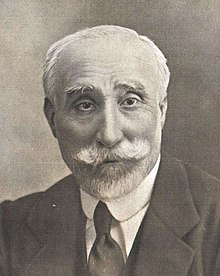Antonio Maura
This article needs additional citations for verification. (August 2016) |
Antonio Maura | |
|---|---|
 Photograph by Kaulak | |
| Prime Minister of Spain | |
| In office 5 December 1903 – 16 December 1904 | |
| Monarch | Alfonso XIII |
| Preceded by | Raimundo Fernández |
| Succeeded by | Marcelo Azcárraga |
| In office 25 January 1907 – 21 October 1909 | |
| Monarch | Alfonso XIII of Spain |
| Preceded by | Antonio González de Aguilar |
| Succeeded by | Segismundo Moret |
| Personal details | |
| Born | Antonio Maura Montaner 2 May 1853 Palma de Mallorca (Balearic Islands), Spain |
| Died | 13 December 1925 (aged 72) Torrelodones (Madrid), Spain |
| Signature | |
Antonio Maura Montaner (2 May 1853 – 13 December 1925) was Prime Minister of Spain on five separate occasions.
Early life[]
Maura was born in Palma, on the island of Mallorca, and studied law in Madrid.[1] In 1878, Maura married Constancia Gamazo y Calvo, the sister of Germán Gamazo. They had several sons and a daughter together, many of whom have been prominent in Spanish and European history.
Political career[]
He entered the Cortes Generales in 1881 as a Liberal delegate for Majorca but later joined the Conservative Party. In 1886, Maura was elected vice president of the Congress of Deputies.
As prime minister, he created the Spanish Institute of Provision and attempted to carry out a reform plan, but it was opposed by the liberals. He fell from power after his suppression of an uprising in Barcelona in 1909, called the Tragic Week. The execution of Francisco Ferrer, who was charged with leading the uprising, provoked a European-wide outcry that contributed to Maura's downfall.
Maura was a hero of a youth movement, the Mauristas, that wanted him as a new head of state of Spain at a time of substantial resentment of King Alfonso XIII. That and Maura's ambition caused him to fall out with the King. Maura later headed coalition cabinets with other parties (1918, 1919, 1921–22) but did nothing to advance unconstitutional methods. Many of his followers later supported the dictatorship of Miguel Primo de Rivera, but he remained aloof from both Primo de Rivera and the King. Maura had first entered the political arena to fight the caciquismo culture, which he considered a cancer of Spanish political culture and the main obstacle to authentically-democratic institutions.
When he was prime minister, he spent summers at the estate of Can Mossenya, historically part of the Valldemossa Charterhouse in Mallorca, and Chopin and George Sand had stayed there in the previous century. Azorín traveled from the continent to meet Maura there.[2] Maura became a prolific watercolourist who often painted scenes of nature or old buildings from past eras.[3]
He died in Torrelodones, a small town in the Guadarrama mountains, north-west of Madrid, in 1925.[4] The International Foundation Can Mossenya named an entrance to its historic estate, the "Gate of Friendship – Azorín and Maura", after the men's encounter.[5]
Descendants[]
- Gabriel Maura y Gamazo (son) – historian and Minister of Labour
- Honorio Maura y Gamazo – playwright and monarchist deputy, killed by leftist militia in 1936
- Miguel Maura y Gamazo (son) – Minister of Security
- Susana Maura y Gamazo (mother of Jorge and Carlos Semprún)
- Constancia de la Mora Maura (granddaughter) – writer, Foreign Press Officer (Spanish Republic)
- Jorge Semprún y Maura (grandson) – writer, communist and Minister of Culture
- Carlos Semprún y Maura grandson) – writer and journalist
- Jaime Semprún (great-grandson) – writer
- Ricardo Semprún (great-grandson) – diplomat
- Pablo Semprún (great-grandson) – professional paddle tennis player
- Luisa Isabel Álvarez (great-granddaughter)
- Jaime Chávarri y de la Mora (great-grandson) – film director
- Soledad Fox Maura Semprún - academic & writer
See also[]
References[]
- ^ "In Place of Splendour", Constancia de la Mora, London, Michael Joseph, 1940, p.13
- ^ The International Foundation Can Mossenya Friends of Borges – amigos-de-borges.net
- ^ "In Place of Splendour", Constancia de la Mora, [2nd edition], London, The Clapton Press, 2021, p.50
- ^ "In Place of Splendour", Constancia de la Mora, [2nd edition], London, The Clapton Press, 2021, p.97
- ^ "The International Foundation Can Mossenya", Friends of Borges – amigos-de-borges.net
External links[]
| Wikimedia Commons has media related to Antonio Maura. |
- 1853 births
- 1925 deaths
- People from Palma de Mallorca
- Prime Ministers of Spain
- Members of the Royal Spanish Academy
- Conservative Party (Spain) politicians
- Justice ministers of Spain
- Leaders of political parties in Spain
- Interior ministers of Spain
- Overseas ministers of Spain
- Knights of the Golden Fleece of Spain
- Honorary Knights Grand Cross of the Royal Victorian Order